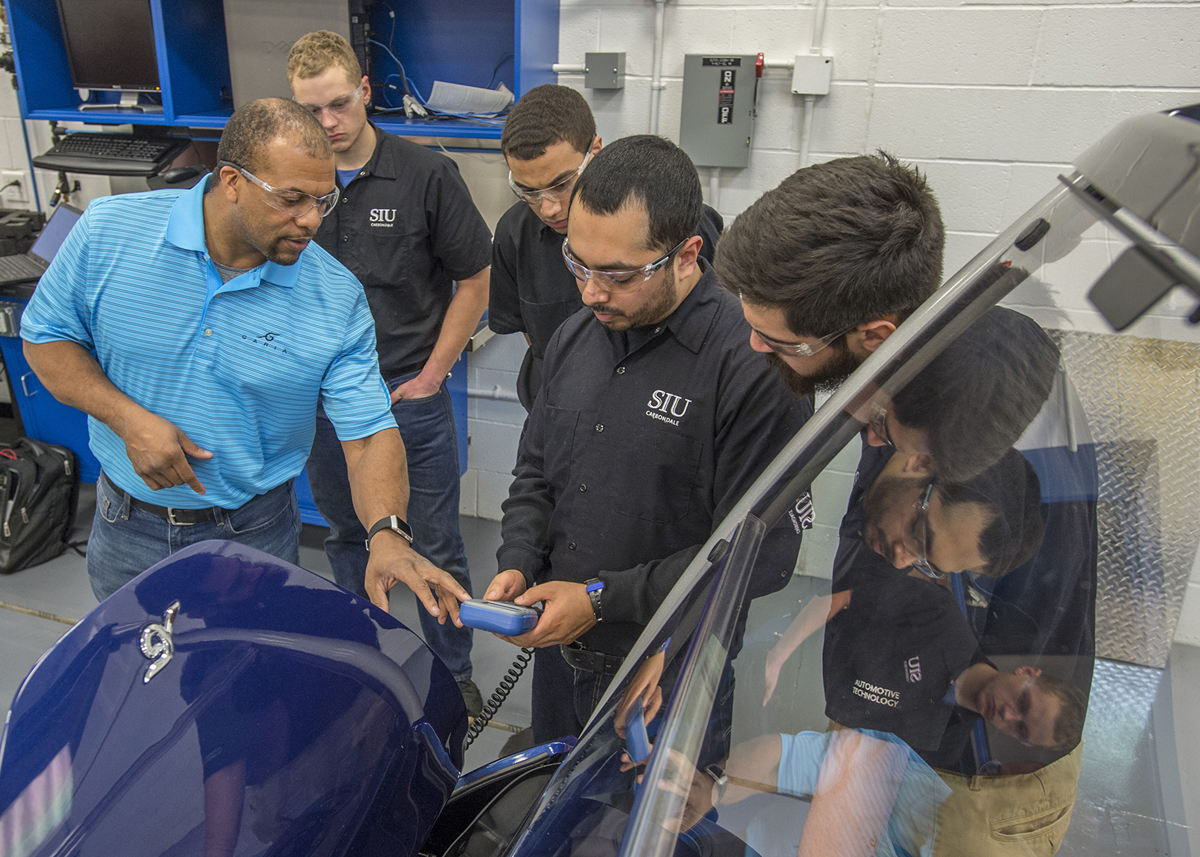
Electric vehicle research – James Seargent, left, technical director for Garia’s North American operations, discusses electrical batteries on one of the company’s golf carts with students in SIU Carbondale’s automotive technology program. Students will be assisting the Scandinavian low speed vehicle and golf car manufacturer in research and development of improved lithium batteries for use in the company’s vehicles, along with working on technical service manuals. (Photo by Russell Bailey)
February 27, 2019
Going the extra mile: Automotive students involved with lithium battery research, development
CARBONDALE, Ill. — Students in Southern Illinois University Carbondale’s automotive technology program will be assisting a Scandinavian low speed vehicle and golf car manufacturer in research and development of improved lithium batteries for use in the company’s vehicles.
Some of the research will involve how far the utility vehicles can go on a single charge under varying conditions, speed and acceleration programming and controller area network (CAN) communication. In addition, students are also working with Garia Inc., to update the Denmark-based company’s technical service manuals for dealers throughout the world.
Michael Behrmann, department chair, notes the project perfectly aligns with the SIU mission as the only automotive technology program in the world that is part of a major research university. Students will not only learn cutting-edge technology but will work to further the development of “the next cutting edge.”
“That’s the type of project this is,” he said. “Not only are we teaching the most up-to-date technology and systems, we are working with our students, faculty and Garia together to take everyone to the next level.”
Research will be a part of classes
The different projects will be incorporated into students’ classes and enable them to engage with the corporation, their personnel and product as they work on developing the next cutting-edge technology, Behrmann said.
Technology is similar to those found in automobiles
The lithium battery technology and computers found on Garia vehicles are very similar to those on a Tesla or other electric vehicles, said James L. Seargent, the company’s technical director for North America. Utilizing the department’s dyno and faculty and student expertise, the anticipated tests will help determine how to best build software to fit customers’ needs for a myriad of uses.
Seargent explained some users, such as the Swedish postal service, Post Nord, utilize their vehicles daily while others might not use them for weeks. Simulating charging behaviors and driving patterns in varying elevations, temperature and conditions will help in technology for extending battery life, he said.
Jessica Suda, an assistant professor in automotive technology, said the two-fold project is beneficial to her students. The dyno testing will go to research involving vehicle range and different battery combinations and the service manual work will go toward transforming engineering documents into something technicians can use.
A “really good fit for students”
Seargent, a 2003 automotive technology alumnus originally from Madisonville, Kentucky, is an active member of the department’s National Advisory Board. Garia was a “really good fit” with students came to the board suggesting a need for additional opportunities with electrical technology. Many automotive schools across the country do not have access or opportunity to work with the same variety of vehicles as SIU, he said.
“When we saw the need that students were asking for, it was pretty easy for me to say, ‘Hey, our electrical vehicle, although small, is highly technical and easy for them to get to the right components for testing’.”
Christoffer Hansson, Garia’s chief operating officer, then came to Southern Illinois earlier this year to meet with Behrmann and tour the facility.
Growing markets for electric vehicles
Behrmann and Seargent each said there are growing markets for electric vehicles, both in the United States and Europe. In several European communities, gasoline-powered trucks have limited access that require electric utility distribution deliveries within city limits. In addition, retirement communities and many urban areas in the United States are seeing a growth in the use of electric vehicles.
Already working on service manuals
Seargent is based out of Garia’s U.S. headquarters in Houston, Texas. He spent a few days recently at the university’s Transportation Education Center showing students the vehicle, reviewing engineering drawings and the wiring schematics for the service manuals.
Jamie Romo, a senior from Joliet, said key selling points for attending SIU were professors’ years of experience with cutting-edge new vehicles and research projects, like the one with Garia, along with alumni support.
This project “will help me develop better technical writing skills and understand the new innovative technology Garia has in their vehicles,” he said. “Someday that technology may be applied to the automotive industry.”
Christian Rodriguez, a senior from Oswego, said the project allows him to “think outside the box and test the knowledge that I already have.”
Rodriguez said there are some items the group wants to add to the service manuals that will be created. He mentioned that auto manufacturers lack labeling wiring diagrams and do not have “how-to videos” in their procedures.
Working on electrical vehicle systems is beneficial
Sergio Rangel Jr., a senior from Aurora, agrees the research and work with the Garia project is beneficial. Receiving “real-world” experience and having the opportunity to expand his knowledge on electric vehicle systems and components while improving his technical writing abilities is key, he said.
“Aside from having a good understanding of automotive systems that are out today, having the ability to communicate complex information to multiple groups in the industry is just as important,” he said.
